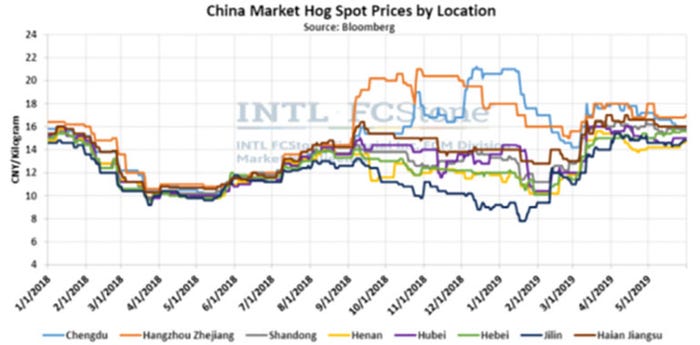If no fire yet in China, where is all the smoke coming from?
The trade war has had a negative impact on Chinese businesses and it is quite likely that individual incomes are under some pressure. There simply isn’t enough money to push prices higher.
June 3, 2019

We won’t be gathering in Des Moines for another World Pork Expo this week but if we were, China would certainly dominate the conversation. And the most frequent question might well be “What is taking so long?!!!!” The No. 2 pork eaters in the world (citizens of the European Union actually eat slightly more pork per person but, of course, there aren’t nearly as many of them) seem to be faring fine without having nearly as much pork available. Or so the thinking goes at present.
Let’s review what we think we know. The disease appeared in August and, in spite of the limited news from the government and the reassurances that everything is now under control, non-government sources are in pretty much agreement that 25 to 35% of China’s pig inventory is gone. Some of them died but – and this is key – many of them simply got pushed to slaughter. What we missed, it appears, is the impact those pigs had on China’s frozen pork inventories. There is no equivalent to our cold storage report for China. There is simply talk and the preponderance of that talk points to massive domestic inventories being built. Those have been and will be used to mitigate the supply impact of African swine fever – for a while.
Prices are indeed higher in China but they have been remarkably stable since mid-March. In fact, as can be seen in Figure 1 from our colleagues at INTL FCStone, market hog prices have trended slightly lower. What happened to the shortages? Where is the consumer panic? Have the communists found a way to ignore the rules of economics?

I doubt that. Nationalistic fervor can go a long way in these situations and we must not underestimate the willingness and ability of the Chinese people to endure a difficult situation. They have done it before and can do it again if properly motivated. The actions of the United States in the trade war have no doubt fueled that willingness to some degree. I haven’t seen them calling us “Great Satan” or burning Old Glory but I doubt that there are many compliments floating around.
When the price of one good rises it puts upward pressure on the prices of substitutes. We have observed chicken and beef prices increased dramatically from last fall through early this year (see Figure 2, again courtesy of FCStone). But that upward pressure has waned. Chinese buyers have been actively pursuing beef and chicken supplies but there simply is not enough of either to fill the size of shortfall that has apparently occurred in China’s hog business. There may eventually be but there isn’t now.
So why have pork, beef and chicken prices not continued upward? There are two likely reasons.
First, fear may have taken a chunk out of China's pork demand. We heard some of that early on but it hasn’t been a hot topic lately. A decline in pork demand in and of itself should appear as higher demand for substitutes. Figure 2 suggests that has happened to some degree but it isn’t as much as I would expect.
I think the answer is that pesky thing called an income constraint. The demand for any good depends on tastes and preferences, the price of the good, the prices of substitute and complement goods and INCOME. Fear of ASF would fall under tastes and preferences. We have addressed the prices and Chinese consumers have only so much money to spend. The trade war has had a negative impact on Chinese businesses and it is quite likely that individual incomes are under some pressure. There simply isn’t enough money to push prices higher. Chinese consumers are simply eating less protein with pork being the big volume loser and increases in chicken and beef being limited by quantities available around the world.
Is that the last word? No. Food inflation is starting to rise and the Chinese government has moved heaven and earth before to prevent that. They will likely take action to mitigate higher prices even if they don’t solve the problem completely. We have talked to several U.S. packers that have talked to COFCO, China’s government importing company, about sizable shipments of U.S. pork. Those shipments would apparently not incur a tariff since COFCO is, in essence, a government entity.
One packer shut down a plant for six working days to reconfigure it to efficiently produce and ship the divided carcasses that COFCO prefers. Others have made changes to ship three- or six-piece carcasses as well.
If there is no fire, where is all the smoke coming from? And yet our markets struggle as the anticipation wanes and attitudes sour.
“Dad, are we there yet?”
“No. But we get closer every time the tires go round,” I would say. No, it didn’t work for my kids either.
Comments in this column are market commentary and are not to be construed as market advice. Trading is risky and not suitable for all individuals.
Source: Steve Meyer, who is solely responsible for the information provided, and wholly owns the information. Informa Business Media and all its subsidiaries are not responsible for any of the content contained in this information asset.
About the Author(s)
You May Also Like





